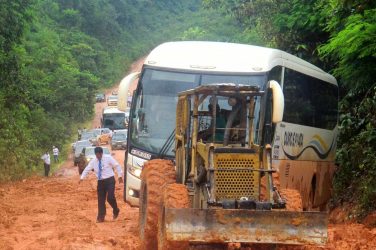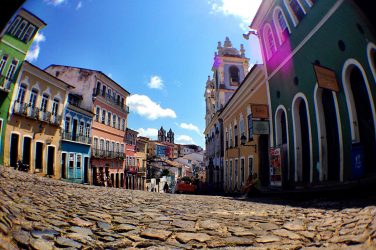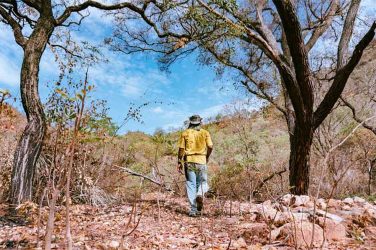
Pipa was the first city in Brazil where people used ketchup,
chewing gum, and blue jeans. The
3000-residents little town, however,
has much more than that to its credit. Its charm comes from its
natural beauty combined with its colorful international population.
For you real beach lovers the Northeast of Brazil is a paradise of endless opportunities to find your perfect beach.
There are beaches to surf, canoe, sunbathe, windsurf, swim, take long walks, horseback ride, watch dolphins, ride the dunes
with off-road vehicles, take boat trips, snorkel, people watching on crowded beaches, or find your own secluded piece of
sand and waves for as far as you can see. I have seen most of the Northeast and the place where all of these pleasures to be
found for true nature lovers is the small town called Pipa (say peepa).
This charming little town of about 3000 inhabitants lies 50 miles south of Natal the state capital of Rio Grande Do
Norte. Natal is the fun capital of the Northeast. It means Christmas in English because it was founded December 25, 1598,
Christmas Day. This was the first city in Brazil where people used ketchup, chewing gum, and blue jeans because of the presence
of US military base during Second World War. Pipa’s charm comes from its beautiful natural setting combined with its
colorful international and Brazilian native inhabitants. Here you will find surfers, artists, hippies, businessmen, from several
countries mixed in with the local population.
More than half of the local businesses are owned by foreigners who created their tropical Brazilian paradise mixed
with their own international ideas and backgrounds. Pipa offers a wide variety of excellent restaurants,
pousadas and activities blended in total harmony with the natural surrounding of the green forests, the golden sand dunes and blue ocean.
There are no five star hotels or huge shopping malls. This is a place where you can get in touch with nature in its
grandest form and enjoy simple things in life.
Most of the natives don’t speak much English but if they do, their vocabulary includes these seven important
words: “don’t worry man, you are in Pipa”
A typical day in Pipa begins with having a breakfast of local fruits, freshly baked bread and cakes, accompanied with
coffee or freshly squeezed juices. This is the only meal which is typically included in your
pousada’s daily rate. After breakfast you can either take one of the interesting excursions, or just walk down to one of the beaches in town. There are four of them
and each one is different. All of the
pousadas have a list of the available excursions, some of the best are, canoeing in Tibau
do Sul, 2-3 hours and about 10 dollars.
Make sure you choose a fish to be grilled for lunch at the restaurant on the beach the excursion departs from; you
will be hungry when returning. Another interesting trip is a dune buggy ride to Sagi, it is 5-6 hours of gorgeous beaches one
after the other. Do not forget to douse yourself with sunscreen before you go! This trip is about 60 to 80 dollars for 4 people,
depending on the buggy and season. There are other trips to the ecological reserve, north to Natal, and Maracajaú to snorkel.
After taking one of the trips, watch the sunset or the local fishermen returning from sea with their catch. In the
evening, there is an excellent choice of restaurants to have a relaxing dinner. Some of the best are: Casita de Don Arturo (Spanish
cuisine, very good paella for about 18 dollars for two); Pizzeria Pipa Brasil (about 100 types of pizza); Cruzeiro do Pescador
(excellent seafood); and Soparia Chez Liz, which serves some of the best soups I ever had. Basically in my experience you can’t
go wrong with any of the restaurants in Pipa. After dinner there are a couple of good bars. The most popular one is Boate
dos Calangos for dancing or drinks, but don’t go there before 11 pm.
Some of the best places to stay if you are looking for seclusion are Pousada Ponta do Madeiro and Hotel Village
Natureza, for around 60 dollars per night. These two are about 3 km from town perched on top of a cliff with fantastic views. You
shouldn’t take small children there though. In Pipa an excellent choice is the Pousada Mirante de Pipa, walking distance to the
beaches and all the restaurants and shopping. Here the air conditioning is the Atlantic forest, the
pousada’s grounds are all under the lovely trees, which keep the whole place comfortably cool all day and night. Instead of TV the rooms have
picturesque views of the town and sea, the entertainment provided by the tiny monkeys begging for bananas on your porch.
The friendly and helpful owners, Gisella and Heitor speak English and will pick you up at the airport in Natal. Daily
rates are from $20 to $50 depending on season. Another good choice is Pousada Cavalo Marinho with beautiful grounds and
pool, although a little more expensive.
High season is the months of December, January, February and July. During these times prices are higher and it is
more crowded.
Pipa is guarantee of year around perfect weather, with at least 300 days of sunny days. Included in the package: no
bugs, close proximity to a major city and airport, virtually no crime, cheap prices, and friendly locals. The place is an excellent
travel destination for those who have an appreciation for nature, beaches, different exotic locations or just have an open mind
to experience all the above.
If you go, just remember what the locals say; “Don’t worry man, you are in Pipa”
On the Web about Pipa: www.pipa.com.br,
www.mirantedepipa.com.br,
www.villagenatureza.com.br
Zoltan Horvath, editor of Planetguides, traveled extensively the northeast of Brazil. You can reach him
at zo@planetguides.com
Discuss it in our Forum
Send
your
comments to
Brazzil









